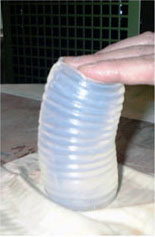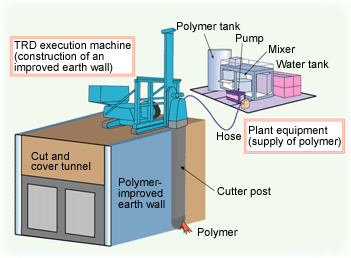|
Because of the collapse of cut and cover tunnels due to ground displacement from the Hyogo prefecture (south) earthquake, reinforcement work against earthquakes has increasingly been carried out on existing tunnels of this type. However, it has not been possible to satisfactorily reinforce these tunnels; although center pillars can be wrapped with steel plates, walls in contact with the ground can be reinforced only on one side. To combat increases in tunnel structure stress due to earthquake ground displacement, the RTRI has proposed a new earthquake-resistance reinforcement method involving the installation of a polymer base isolation wall outside cut and cover tunnels.
The polymer material developed (polyvinyl alcohol gel lump - Fig. 1) exhibits excellent deformability, environmental compatibility and durability, demonstrating appropriate characteristics for buffer (base isolation) material. Earthquake response analysis and model excitation tests have proved the effectiveness of the polymer base isolation layer, showing that shear stress in the side wall decreases to about 50% when the strength (Vs) ratio (polymer base isolation layer to the ground) is 1/100 and the layer thickness is 40cm.
This reinforcement work can be efficiently executed by the trench-cutting re-mixing deep wall (TRD) method that has been applied to ground improvement (Fig. 2), or by replacing the cement milk used in ordinary ground improvement machines with the polymer material.
Calculations for an assumed cut and cover subway tunnel have shown that the costs and time required for this reinforcement work are about half those needed for the conventional one-side steel plate reinforcement method.
 |  |
| Fig. 1 Deformability of polymer gel lump | Fig. 2 Image showing installation of a polymer base insulation layer |
HOME > Major Results of Research and Development in Fiscal 2004 > I Safety/Reliability

RTRI HOME
Copyright(c) 2005 Railway Technical Research Institute,Tokyo Japan, All rights reserved.
|

